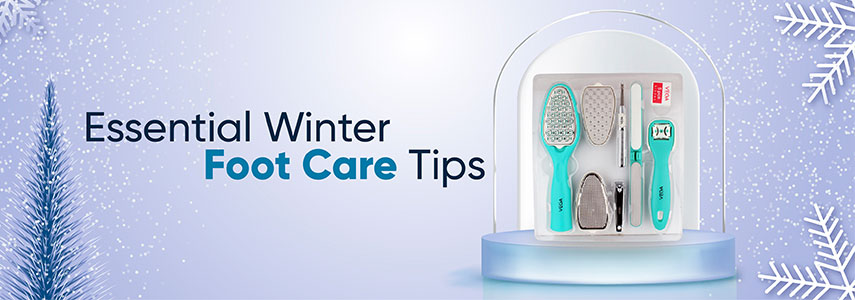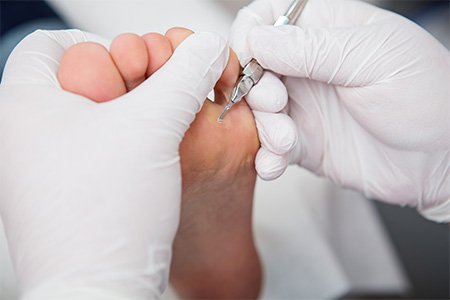Seasonal Foot Care: Expert Tips for Happy, Healthy Feet Year-Round (Guide 2025)
Discover seasonal foot care tips to keep your feet healthy year-round. Adapt your routine with expert advice for summer, winter, spring, and fall. Read more!
As the seasons change, so should our foot care routines. I’ve learned that adapting our approach to foot health throughout the year is crucial for maintaining happy, healthy feet. Just like we swap out our wardrobes, it’s time to adjust our foot care habits to match the weather.
From dry, cracked heels in winter to sweaty, blister-prone feet in summer, each season brings its own set of challenges. I’ll guide you through the essential seasonal foot care adjustments you need to make. By following these tips, you’ll keep your feet looking and feeling great all year round, no matter what Mother Nature throws your way.
Understanding Seasonal Foot Care Adjustments
Seasonal changes significantly impact our feet, requiring customized care routines throughout the year. I’ve found that adapting foot care practices to summer and winter conditions is crucial for maintaining healthy, comfortable feet.
Summer Foot Care Essentials
Summer presents unique challenges for foot health. Higher temperatures and increased outdoor activities can lead to sweaty feet, blisters, and fungal infections. Here’s how I adjust my foot care routine for the warmer months:
- Cleanliness: I wash my feet daily with antibacterial soap and dry thoroughly, especially between toes.
- Breathable Footwear: I opt for sandals, open-toed shoes, or mesh sneakers to reduce sweat buildup.
- Moisture-Wicking Socks: I choose cotton or bamboo socks to keep feet dry.
- Sun Protection: I apply sunscreen to exposed foot areas, including tops and ankles.
- Blister Prevention: I take regular breaks during extended outdoor activities and avoid going barefoot in public areas.
Winter Foot Care Strategies
Cold weather brings its own set of foot care challenges, such as dry skin and reduced circulation. My winter foot care routine includes:
- Moisturizing: I apply a thick, emollient cream daily to prevent dry, cracked skin.
- Proper Footwear: I wear insulated, waterproof boots to protect against cold and moisture.
- Warm Socks: I choose wool or thermal socks to maintain foot warmth and wick away moisture.
- Circulation Boost: I perform foot exercises and massages to improve blood flow.
- Hydration: I drink plenty of water to keep skin hydrated from the inside out.
By adjusting my foot care routine seasonally, I ensure my feet remain healthy and comfortable year-round.
Summer Foot Care Strategies
Summer brings unique challenges for foot health. Here are essential strategies to keep your feet comfortable and protected during the hot months.
Protecting Against Heat and Sun Exposure
Sun protection isn’t just for your face and body; your feet need it too. I recommend applying sunscreen with at least SPF 30 to the tops of your feet, especially when wearing sandals or open-toed shoes. This prevents painful sunburns and reduces the risk of skin damage. For added protection, opt for UV-resistant footwear when spending extended time outdoors. These specially designed shoes shield your feet from harmful rays, offering an extra layer of defense against sun-related foot problems.
Managing Moisture and Preventing Fungal Infections
Summer’s heat and humidity create ideal conditions for fungal growth. To combat this, I suggest wearing breathable footwear like sandals or mesh sneakers. These allow air circulation, reducing moisture buildup. When choosing socks, opt for moisture-wicking materials such as cotton or bamboo. These fabrics draw sweat away from your skin, keeping your feet dry and less prone to fungal infections. After swimming or showering, thoroughly dry your feet, paying special attention to the areas between your toes where fungi thrive.
Choosing Appropriate Summer Footwear
Selecting the right summer footwear is crucial for foot health. I recommend sandals with good arch support and cushioning for everyday wear. These provide comfort while allowing your feet to breathe. For active days, choose lightweight, breathable athletic shoes that offer proper support and stability. Avoid flip-flops for extended walking, as they provide minimal support and can lead to foot strain. When shopping for summer shoes, try them on in the afternoon when your feet are slightly swollen to ensure a comfortable fit throughout the day.
Fall Foot Care Considerations
As autumn arrives, it’s crucial to adjust your foot care routine. The changing weather and footwear choices require exact attention to maintain healthy feet during this transitional season.
Transitioning from Open to Closed Shoes
Switching from sandals to closed-toe shoes demands careful consideration. I recommend ensuring proper fit to prevent blisters and bunions. Select footwear with ample toe room and good arch support to avoid foot fatigue. Moisturize your feet regularly to combat dryness caused by enclosed shoes. Choose breathable materials like leather or mesh to promote air circulation. Gradually increase wear time of new fall shoes to allow your feet to adjust comfortably. Remember to trim toenails straight across to prevent ingrown nails, which can be exacerbated by tighter footwear.

Addressing Fungal Concerns in Cooler Weather
Cooler temperatures and increased moisture create ideal conditions for fungal growth. I advise using antifungal powder in shoes and between toes to prevent infections. Change socks daily, opting for moisture-wicking materials to keep feet dry. After bathing, thoroughly dry feet, especially between toes. Consider using a UV shoe sanitizer to eliminate bacteria and fungi in footwear. If you notice any signs of fungal infection, such as itching or discoloration, consult a podiatrist promptly. Avoid walking barefoot in public areas like locker rooms or pool decks to reduce exposure to fungal spores.
Winter Foot Care Essentials
Winter presents unique challenges for foot health, requiring exact care to combat dryness, prevent frostbite, and choose appropriate footwear. I’ll share essential tips to keep your feet healthy during the cold months.
Combating Dryness and Cracking
To combat winter’s drying effects on feet:
- Moisturize daily with thick creams or petroleum jelly
- Apply moisturizer to damp skin for better absorption
- Use heavy foot creams before bed, wearing socks overnight
- Limit hot showers or baths, opt for lukewarm water
- Avoid prolonged water exposure to prevent skin dehydration
- Exfoliate gently to remove dead skin cells, improving moisturizer effectiveness
- Consider using a humidifier to add moisture to indoor air
Preventing Frostbite and Chilblains
Protect feet from cold-related injuries:
- Wear moisture-wicking socks to keep feet dry
- Layer thin socks under thicker ones for added insulation
- Limit time outdoors in extreme cold
- Keep feet moving to maintain circulation
- Warm feet gradually if they become cold, avoid direct heat
- Change out of wet socks immediately
- Recognize early signs of frostbite: numbness, hard or waxy-looking skin
- Seek medical attention if symptoms persist or worsen
- Opt for insulated, waterproof boots for snowy conditions
- Ensure boots fit properly, allowing room for thick socks
- Look for non-slip soles to prevent falls on icy surfaces
- Consider boots with removable liners for easy drying
- Invest in quality materials like Gore-Tex for breathability and waterproofing
- Avoid tight-fitting shoes that restrict circulation
- Rotate footwear to allow proper drying between uses

Spring Foot Care Tips
Spring brings new challenges for foot health. As temperatures rise and outdoor activities increase, it’s crucial to adjust your foot care routine. Here are essential tips to keep your feet healthy and comfortable during the spring season.
Dealing with Allergies and Skin Sensitivities
Spring allergies can affect your feet, causing itching and discomfort. I recommend using hypoallergenic foot products and avoiding scented lotions to minimize irritation. If you experience sudden rashes or swelling, consult a podiatrist immediately. For those with sensitive skin, opt for natural, fragrance-free moisturizers and wear breathable, moisture-wicking socks to reduce sweating and potential skin reactions. Regular foot soaks in cool water with a tablespoon of baking soda can help soothe irritated skin and provide relief from allergy symptoms.
Preparing Feet for Increased Activity
As spring encourages more outdoor activities, it’s essential to prepare your feet for increased movement. I suggest starting with gentle foot exercises to improve flexibility and strength. Gradually increase your walking or running distance to avoid overuse injuries. Invest in properly fitting athletic shoes with good arch support and shock absorption.
Before captivating in high-impact activities, warm up your feet by rotating your ankles and stretching your toes. After exercise, cool down with a gentle foot massage to promote circulation and reduce soreness. Remember to listen to your body and give your feet adequate rest between activities to prevent fatigue and injury.
Year-Round Foot Care Practices
Year-round foot care practices are essential for maintaining healthy feet throughout the seasons. By implementing consistent routines and adapting them to seasonal changes, you can prevent common foot problems and ensure optimal foot health.
Regular Foot Inspections and Hygiene
Regular foot inspections and proper hygiene are crucial for year-round foot care. Inspect your feet daily for any changes, cuts, blisters, or signs of infection. Wash your feet thoroughly with warm water and mild soap, paying extra attention to the areas between your toes. Dry your feet completely, especially in the toe crevices, to prevent fungal growth. Use a pumice stone or foot file to gently remove calluses and dry skin. Apply a moisturizer to keep your feet soft and supple, but avoid applying it between your toes to prevent excess moisture.
Proper Nail Care Techniques
Maintain proper nail care techniques to prevent ingrown toenails and fungal infections. Trim your toenails straight across, avoiding rounded edges. Use clean, sharp nail clippers or scissors designed for toenails. Don’t cut nails too short, as this can lead to ingrown toenails. File any sharp edges to prevent snagging on socks or causing injuries. If you have thick or discolored nails, consult a podiatrist for professional treatment. For those with diabetes or circulation issues, it’s safer to have a professional trim your nails to avoid potential complications.
When to Seek Professional Podiatric Care
Seek professional podiatric care if you experience persistent foot pain, changes in foot appearance, or recurring issues. Contact a podiatrist if you notice signs of infection, such as redness, swelling, or discharge. Diabetic individuals should have regular foot check-ups to prevent complications. Consult a professional for persistent athlete’s foot, plantar warts, or ingrown toenails that don’t respond to home treatment. If you develop new growths, experience changes in skin color, or have difficulty walking, schedule an appointment with a podiatrist. Early intervention can prevent minor issues from becoming major problems.
Conclusion
Adapting your foot care routine to each season is crucial for maintaining healthy feet year-round. By following these seasonal tips you’ll be well-equipped to tackle the unique challenges that come with changing weather. Remember that consistent care and attention to your feet will pay off in comfort and health. Don’t hesitate to consult a podiatrist if you encounter persistent issues. With these strategies in place you’ll be stepping confidently into every season ensuring your feet remain happy and healthy no matter the weather.

